The Grid Toolbar contains a variety of features, integrations, and shortcuts that can be used in conjunction with the other features on the DocumentItems tab.

Show/Hide Etilize Panel
The show/hide Etilize Panel icon will open the Etilize panel on the Document Items tab and let users update, change, and select information from Etilize. This allows users to use the Etilize integration on the DocumentItems Tab for any items that have the manufacturer part number and manufacturer included for items on the tab.

When this icon is selected, the Etilize panel will display below the line items on the DocumentItems tab to allow for any changes or updates.
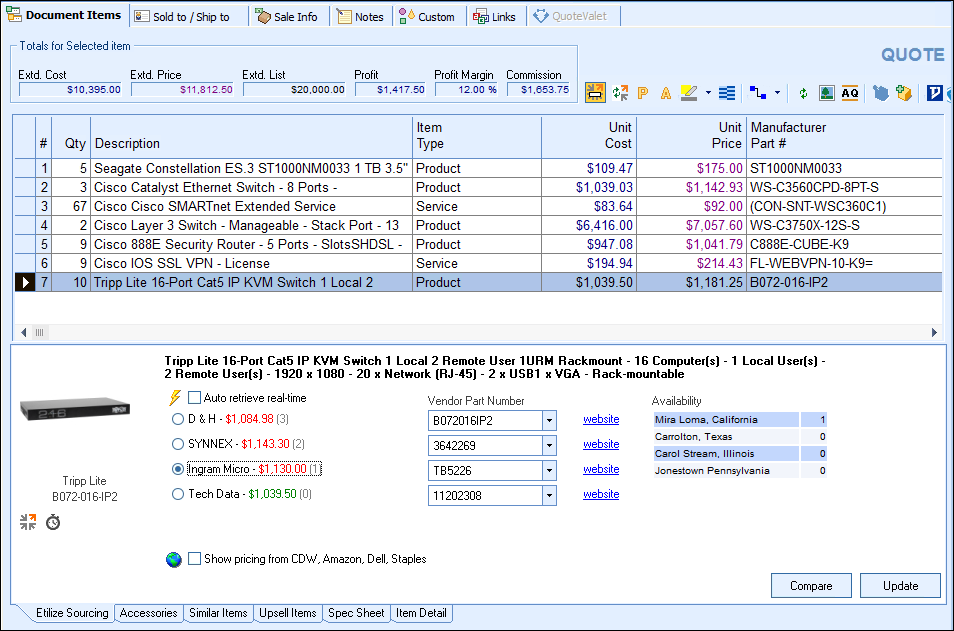
For more information on using the Etilize integration, see our Using the Product Content Subscription topic.
Refresh Item(s) with Etilize Details
The Refresh Item Item with Etilize Details icon will update any selected items on the DocumentItems tab with information from Etilize including pictures, weight, descriptions, and more. This is a useful feature if items have been imported from the Paste Special tool or manually added to a quote and the user would like to retrieve the Etilize product content for those items. For information on how to use Etilize, visit the Using the Product Content Subscription topic.

The P icon directly above the line-items list under the Document Items tab displays unit-price properties for a selected item — the same window that appears under the Edit -> Edit Product/Service properties... menu.

The P icon allows you to adjust the unit price formula of a product or service without having to right-click, or click the Edit menu.
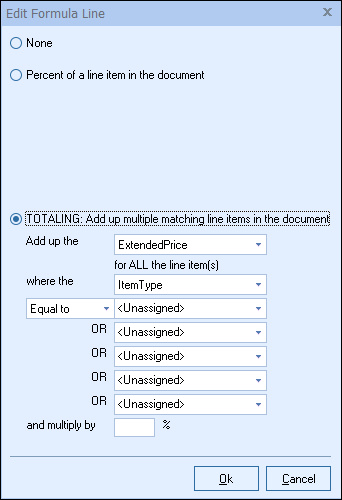
See Formula-based Unit Pricing for more details on the Set Unit Price Formula window.
For more information on the windows that appear based on their line types, see: |
Edit Line Attributes
The A icon directly above the line-items list under the Document Items tab displays the Line Attributes window — the same window that appears under the Edit -> Edit Line Attributes... menu, or when you double-click the row selector for a line item in your quote (![]() , to the far left of the line item).
, to the far left of the line item).

The A icon allows you to edit the attributes of a specific line item without having to right-click, or click the Edit menu.
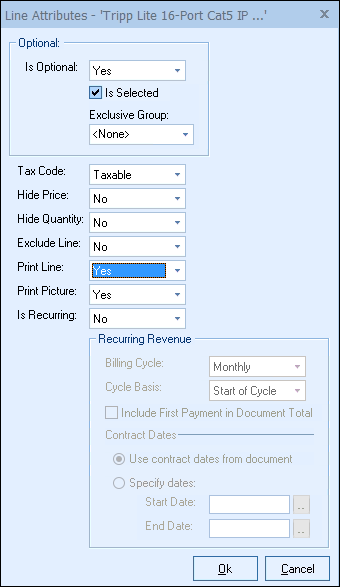
See Line Attributes for more details on the Line Attributes window.
The Highlight Line Items icon will highlight single or multiple selected lines on the DocumentItems tab. Users can choose from seven different colors of Yellow, Orange, Red, Green, Purple, Pink, and Blue. This provides the ability to tag/highlight line items to use as a visual aid such as a line that needs attention, correction, or improvement. This feature can also be used in conjunction with the Notes column to enter notes about what changes need to be addressed. The highlights will only appear on the DocumentItems tab, they will not print on the PDF or be viewable in QuoteValet.
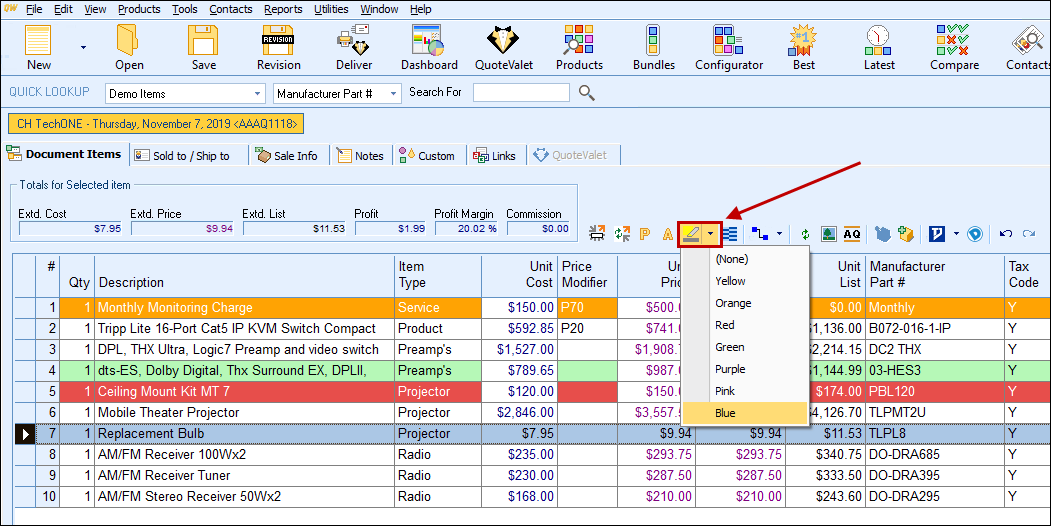
While a line or multiple lines are highlighted and selected on the DocumentItems tab, clicking on the highlight icon ![]() will toggle the color to yellow, and then if pressed again will turn the highlighting off for those items.
will toggle the color to yellow, and then if pressed again will turn the highlighting off for those items.
Users can also edit the color names. For example, instead of the label reading "Yellow" you can edit it as "Needs Review". This lets users customize the colors to be used in their document so everyone in the company uses the same highlight colors for the same purpose.
To change the label for a highlight:
1.Click on Help -> Settings Manager
2.Set "Section" to "System"
3.Click on the new button ![]()
4.In the "KeyName" field type HighlightColor1Label to change the label for Yellow (type HighlightColor2Label to edit Orange, HighlightColor3Label to edit Red, etc).
5.In the "KeyValue" field type the new description into that field. In this example, we typed in "Needs Review"
6.Repeat steps 3-5 to edit the other color labels.
7.Close out of the Settings Manager, restart QuoteWerks and your new label should appear.
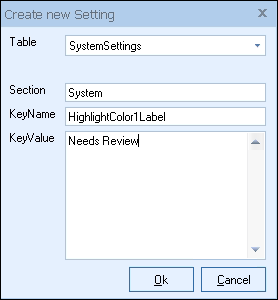
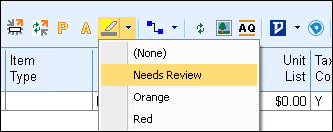
Invert Row Selection
This option selects the the non-selected rows in the document and de-selects the currently select rows.

For example, if you have selected rows 2 and 4, when you use this feature, it would deselect rows 2 and 4 and then select rows 1 and 3.

Set Dependent Quantities (Labor)
This option will link item quantities between various items on the document. This enables users to "tie" a parent item to a single or multiple children items so users can change the quantity of the parent item and the children quantities are adjusted automatically. This functionality is the basis for manually associating labor to items, but can be used with other items as well.
Items can also be set with default dependent quantities by using the Simple Labor tab for the item.
For example, if Widget A has a quantity of 3 and Widget B has a quantity of 9, when linked together using the Dependent Quantities feature, when the quantity of Widget A is changed to 4, Widget B will automatically update to 12.

Using Dependent Quantities is a great way to link items together when the quantity of the items needs to stay in sync with one another. You can link as many items together using this feature.
The Qty. column on the DocumentItems tab has 3 different colors to identify what type of items are set:
![]() = Identifies item as Parent Item
= Identifies item as Parent Item
![]() = Identifies item as Child Item
= Identifies item as Child Item
![]() = Identifies item as both Parent and Child Item
= Identifies item as both Parent and Child Item
Parent Item
A Parent Item is an item that when the quantity is changed, any child items associated with it will automatically readjust in their quantity. This is very useful if you are selling an item that requires labor or any other requirement. For example, if Widget A requires 3 hours of labor for every Widget A you sell, you would setup the dependent quantity to auto-adjust the labor item for Widget A. So if Widget A's quantity changed from 1 to 3, the Labor associated with Widget A, would automatically change from 3 to 9 hours of labor since you are now selling 3 Widgets. This allows you to adjust only the parent item and any associated child items will automatically adjust.
Child Item
A Child Item is an item where the quantity is calculated based on the parent item and it maintains that ratio. For example, if Labor Item A is set as a child item of Widget A, and Widget A has a quantity of 1 and the Labor Item A has a quantity of 3, the parent to child ratio is 1:3.
If we then change the quantity of the parent item to 2, the child item's (Labor Item A) quantity will change to 6 automatically.
Parent and Child Item
Items may be designated as both a parent and a child item. This would change the quantity column to a light purple. An item that is both a parent and child item means that it's quantity will be auto-calculated AND it will also be calculating any child items associated with it.
For example, if "Widget B" was set as a child to "Widget A" and a Parent to "Labor for Widget B", when you change Widget A's quantity, it will adjust the quantity of Widget B and Labor for Widget B automatically.
Setting Dependent Items
To set an item or multiple items as dependents follow these steps:
1.Highlight at least two items. The first item highlighted will be the default Parent item. So be sure to highlight which item you would like to set as the Parent first. In the example below, "Widget A" was highlighted first.

2.With your items highlighted, click on the [Set Dependent Quantity] icon ![]() .
.
3.You will be prompted to set the relative quantity multiplier. This is the ratio you wish to set between the parent and child item(s). For example, if you want the parent item to have a 1:3 ratio to the child item(s), then you would set the relative quantity to 3. So if the Parent item has a quantity of 1, then the child item(s) will have a quantity of 3.
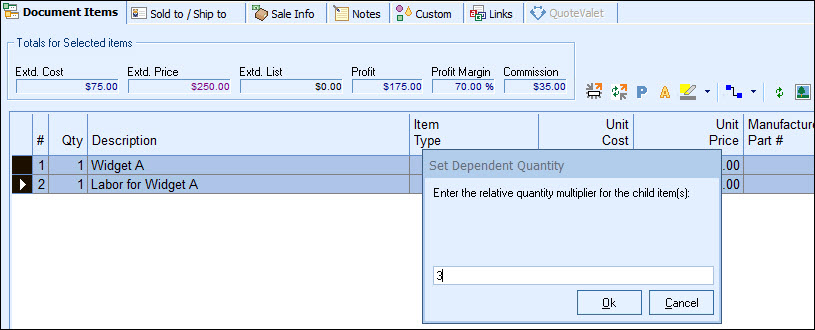
4.Once the relative quantity is set, the quantity columns will update with the new totals (if applicable) and the identifying color.

5.Any changes made to the Parent item (in this example Widget A) will automatically re-calculate the quantity for the child item (Labor for Widget A in this example). So if we change the quantity of Widget A to 3, the Labor for Widget A item will change automatically to maintain the 1:3 ratio that we set.

Unlink Dependent Quantity
When using the Dependent Quantity feature, if you need to unlink a child item from a parent item, you can use this option to unlink it. Additionally, manually changing the child item's quantity will also unlink it from the parent item.
Highlight Dependent Quantity Parent
When using the Dependent Quantity feature, you may have multiple parent items with multiple child items. This can make it difficult to know which parent item is updating which child item(s). To make it easier to identify which parent items are associated with which child items, you can simply highlight any child item and on the drop-down menu for the [Set Dependent Quantity] icon ![]() , there will be an option called "Highlight Dependent Quantity Parent". This option will highlight the parent item for that particular child item to easily identify it so you can make changes to the quantity if needed.
, there will be an option called "Highlight Dependent Quantity Parent". This option will highlight the parent item for that particular child item to easily identify it so you can make changes to the quantity if needed.
Highlight Dependent Quantity Children
When using the Dependent Quantity feature, you can easily identify the child items associated with a particular parent item. Highlight the parent item that you wish to view the child items for and on the drop-down menu for the [Set Dependent Quantity] icon ![]() , there will be an option called "Highlight Dependent Quantity Children". This option will highlight the child item(s) for that particular parent item to easily identify them.
, there will be an option called "Highlight Dependent Quantity Children". This option will highlight the child item(s) for that particular parent item to easily identify them.
|
Refresh Item Details
For information on refreshing item details with data from your product sources, please see the Refresh Item Details topic.

Selecting Pictures/Videos for Items Manually
If a picture and/or video has not been added on the for an item through the edit product menu, you can manually associate a picture and/or video with a line item in the quote. There is a "Show/Hide Set Picture/Video Panel" button ![]() on the Document Items of the Quote WorkBook. This button is located next to the Totals for Selected items window in QuoteWerks on the Document Items tab. To enable this feature, highlight an item in the quote and click on the
on the Document Items of the Quote WorkBook. This button is located next to the Totals for Selected items window in QuoteWerks on the Document Items tab. To enable this feature, highlight an item in the quote and click on the ![]() button in QuoteWerks. You can manually specify a picture and/or video for line types of Products/Services, Group Header, Heading, Comments, Summary, Subtotal, Running Subtotal, Percent Charge, and Percent Discount lines.
button in QuoteWerks. You can manually specify a picture and/or video for line types of Products/Services, Group Header, Heading, Comments, Summary, Subtotal, Running Subtotal, Percent Charge, and Percent Discount lines.

This will display a new panel making it easy to see the current picture and associate a picture with the item. You can also drag a picture file onto the [Select Picture] button.
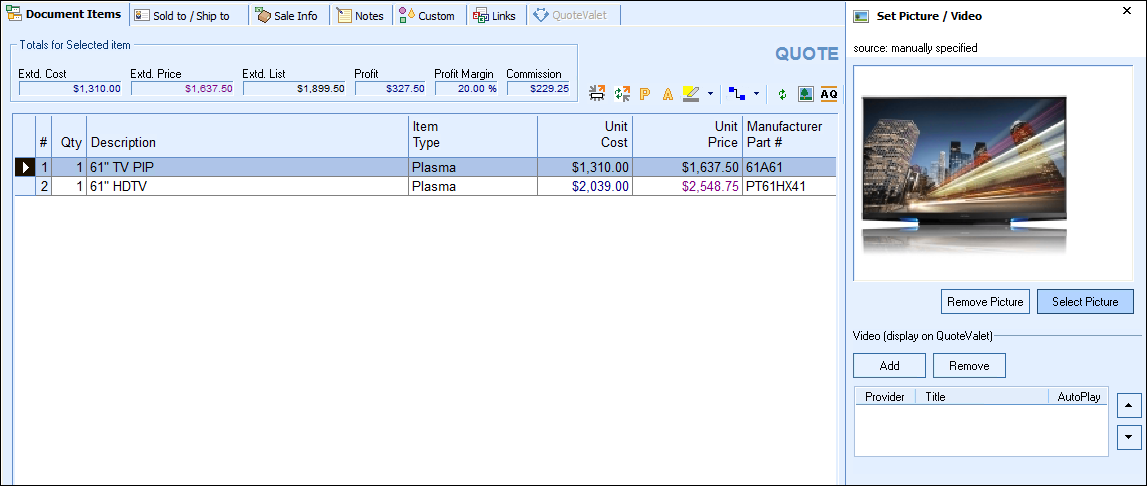
To set a default picture for an item, visit the Editing Products topic.
For more information on setting up a video for a line item in QuoteValet, visit the Setting Line Item Videos topic.

The Active Quotes Panel will display any active quotes for a contact selected on the Sold to / Ship to Tab. The ![]() icon on the grid toolbar on the Document Items tab will toggle this panel on and off. Users will also be able to close out of the panel by clicking on the 'X' of the panel. Any documents that are still active (not converted to closed, won, lost, etc) will be listed in this panel. If a listed quote is a revision of the original, an [R] indicator will appear after the document number.
icon on the grid toolbar on the Document Items tab will toggle this panel on and off. Users will also be able to close out of the panel by clicking on the 'X' of the panel. Any documents that are still active (not converted to closed, won, lost, etc) will be listed in this panel. If a listed quote is a revision of the original, an [R] indicator will appear after the document number.
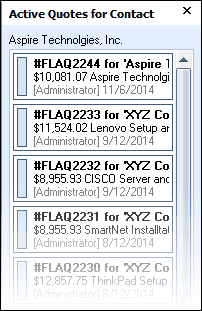
Users are able to access these documents by right-clicking on them to open them in QuoteWerks. Furthermore, if the document is old and can be converted to lost, users can right-click to convert the document to lost without having to open it first.
There are two ways to request the latest shipping rates from carriers and bring them into QuoteWerks.
Important: You must have an account with FedEx and/or UPS to do this. See Shipping Rates in QuoteWerks for information on how to set up this feature. |
First, you can add a new line item to the quote. To do this, click the shipping icon (![]() ) directly above the line-items list under the Document Items tab, or select the Tools -> Shipping Estimator menu.
) directly above the line-items list under the Document Items tab, or select the Tools -> Shipping Estimator menu.
Your second option is to calculate a shipping amount for the entire document instead of a single line item. To do this, click ![]() next to the Shipping display at the bottom of the Quote Workbook.
next to the Shipping display at the bottom of the Quote Workbook.
The Shipping Amount window will appear, enabling you to add shipping manually, add up the charges per line item or based on weight, or use the FedEx/Ups real-time rate quote.
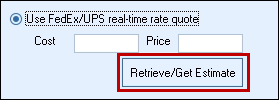
To use FedEx/UPS, simply select the corresponding radio button and click the [Retrieve/Get Estimate] button.
The Add shipping rate item (Get shipping rate, if you’re calculating the entire document) window will appear, where you can start filling in the appropriate data to retrieve the shipping charge from your carrier(s).
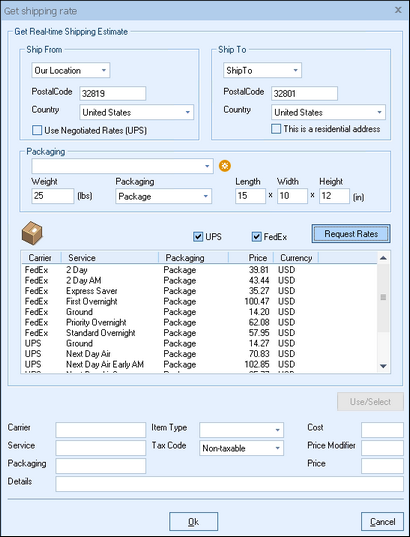
Important: Any field with a |
The Ship From fields pull the zip code from the Our Location fields in QuoteWerks, which you can set under the Tools -> Options menu > Company tab.
|
|---|
The Ship To fields pull from the zip code from the Ship to fields under the Sold to / Ship to tab in the Quote Workbook. You can choose to use the zip code from the Sold to, Ship to, or Bill to fields, or enter a zip code manually. Additionally, F2 Lookup support is enabled for the postal code field under the "Ship From" section. This is useful to create a list of zip codes commonly shipped from to better calculate pricing. "Our Location" or your shipping location is also available in the drop-down list.
Use Negotiated Rates (UPS)
Use this setting when you have negotiated non-standard special rates with UPS to return these rates. On this window, you can toggle this option to see the standard published rates vs your negotiated rates.
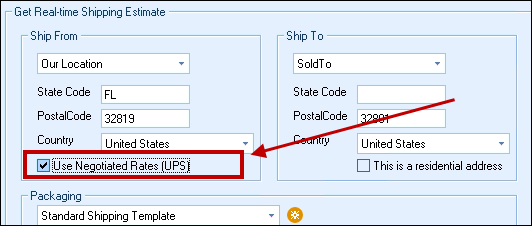
The Packaging section of the window allows you to choose what type of parcel you’re shipping.

Choose "Box," "Envelope," "Package," "Pak," or "Tube" from the Packaging drop-down box and set the weight. If the items on the document already have the weight set in the Unit Weight column on the DocumentItems tab, those combined weights will be set in the weight box. It can be adjusted however. You can also add package dimensions, if applicable.
If you use ship items in the same size box or boxes on a regular basis, you can set a default shipping template that can be used. By filling out the weight, packaging, and dimensions you can then click the ![]() button to create a new shipping template. If the weight is left empty, when using the template the weight of the items on the document will be calculated into the weight field.
button to create a new shipping template. If the weight is left empty, when using the template the weight of the items on the document will be calculated into the weight field.

After the template has been created it will be available in the drop down menu. When selected, it will populate the weight, packaging, and dimensions that you have set. To remove a template, simply highlight it and click the Delete key on your keyboard.
Once you select and fill out your options, choose which carrier(s) you’d like to request rates from (UPS and/or FedEx) under the fields you selected/filled out. Then, click on the [Request Rates] button to search all the rates for each carrier and service.
The results will return, each listing the carrier, type of service, packaging, and pricing information (including currency).
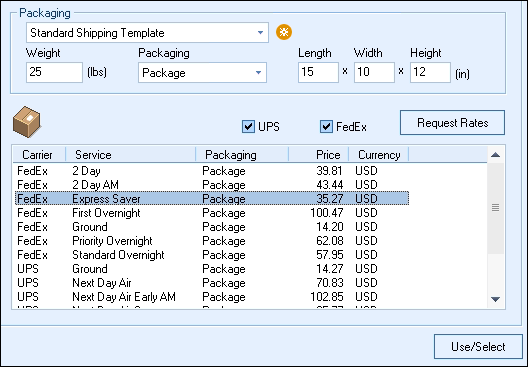
Click on the service you’d like to use, then click on the [Use/Select] button.
Once you’ve selected a service, the corresponding information will populate at the bottom of the window. This will include the Carrier, Service, Packaging, and Details (weight, size, etc). This information is auto-filled, and can’t be adjusted without selecting a different service. You can then select a shipping Item Type and Tax Code.

By default, a line-item shipping rate will populate the Unit Price column under the Document Items tab of the Quote Workbook. To insert the shipping rate into the Document Items tab’s Shipping Cost column instead, select Put Price in ShippingAmount field.
Clicking the appropriate button at the bottom of the window to add your shipping rate to the quote. Add Line is a good idea if you plan to add multiple shipping line items (to allow your customer to choose which shipping method they prefer), while Add Line & Close will add the single line and return you to the Quote Workbook.
After you add the shipping rate to the quote, you can simply select the line item and click the ![]() icon above the line-items list to make any necessary changes. This will launch the Edit shipping rate item window, where you can make any adjustments without having to start from scratch.
icon above the line-items list to make any necessary changes. This will launch the Edit shipping rate item window, where you can make any adjustments without having to start from scratch.
Importing Tech Data Quotations
In addition to Paste Special, there are two other ways to import a Tech Data quote into QuoteWerks. The first is by importing an Excel-formatted quote, and the other is to import the SAP quote from Tech Data’s internal system. However, in order to use these features the Tech Data XML credentials need to have been added to the installation.
Importing Tech Data Excel Quotations
If you’ve purchased the QuoteWerks Real-time Module and have entered your Tech Data USA or Canada real-time credentials, a Tech Data icon (![]() ) will appear above the items list:
) will appear above the items list:

To import a Tech Data Excel quote:
Step 1: Click the ![]() icon, or the arrow next to the icon then Import Tech Data Excel Quote:
icon, or the arrow next to the icon then Import Tech Data Excel Quote:

Step 2: Browse for and select the Tech Data Excel file you’d like to import into QuoteWerks.
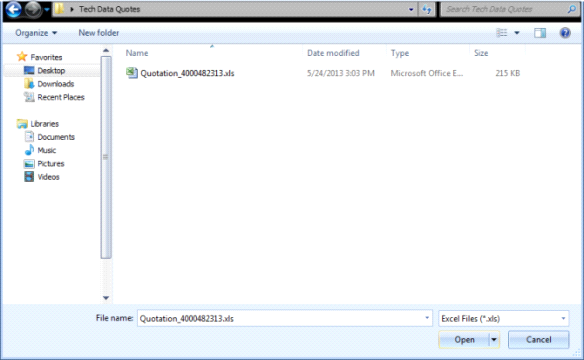
Step 3: Click on the [Open] button, and the Tech Data Excel document will be imported into QuoteWerks. If you select a line item in the quote before importing the Excel file, the Tech Data price quote will be inserted above the selected line. If no line is selected, the Tech Data quote will be imported at the end of the QuoteWerks quote.
The Tech Data quotation number, shipping amount, and freight amount are inserted as a non-printing comment line, for your reference. If any promo notes for the imported items are in the Excel sheet, they’ll appear in the Notes column for each line item. After the Tech Data Excel Price quote file is imported, it will be linked automatically under the Links tab for future reference.
Importing Tech Data SAP Quotations
You can also import a live quote from Tech Data’s SAP system into QuoteWerks. This feature is only available for Tech Data USA SAP quotes.
To do so, click the arrow next to the ![]() icon, then click Retrieve Tech Data SAP Quote.
icon, then click Retrieve Tech Data SAP Quote.

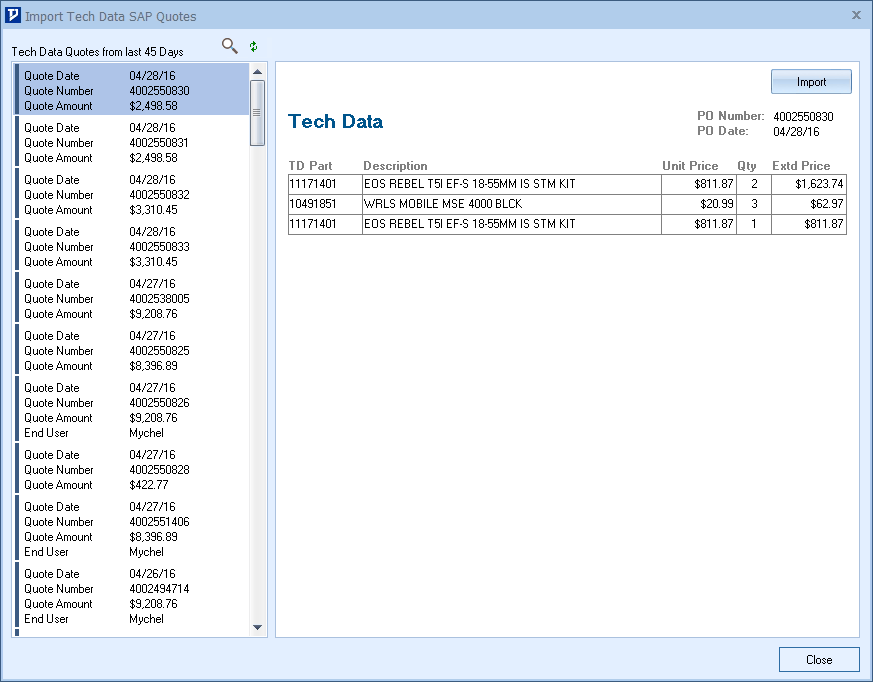
The resulting window will display all of the Tech Data quotes from the last 45 days. Highlight a quote to see the items that comprise that quote or click on the magnifying glass to search by the quote number.

Once you have located your SAP quote, simply click on the [Import] button to import that quote into QuoteWerks. The line items will be added to the current open document in QuoteWerks.
Note: This feature only includes SAP quotes and does not support Tech Data StreamOne quotes for importing. |
|
|---|
The Dell Punchout Integration requires the Real-time module and Dell Punchout credentials. For information on using this feature, please view the Dell Integration topic.
![]()
Note: You will only see the Dell icon if you have the Real-time module and have setup the integration. |

Clicking ![]() above the line-items list will undo the previous action.
above the line-items list will undo the previous action.
You can use this undo feature up to 10 levels. The keyboard shortcut [CTRL+Z] will also apply this feature. Clicking ![]() will redo the previous action. This allows you to quickly reapply a change that may have been undone by mistake. The keyboard shortcut [CTRL+Y] will also apply this feature.
will redo the previous action. This allows you to quickly reapply a change that may have been undone by mistake. The keyboard shortcut [CTRL+Y] will also apply this feature.
